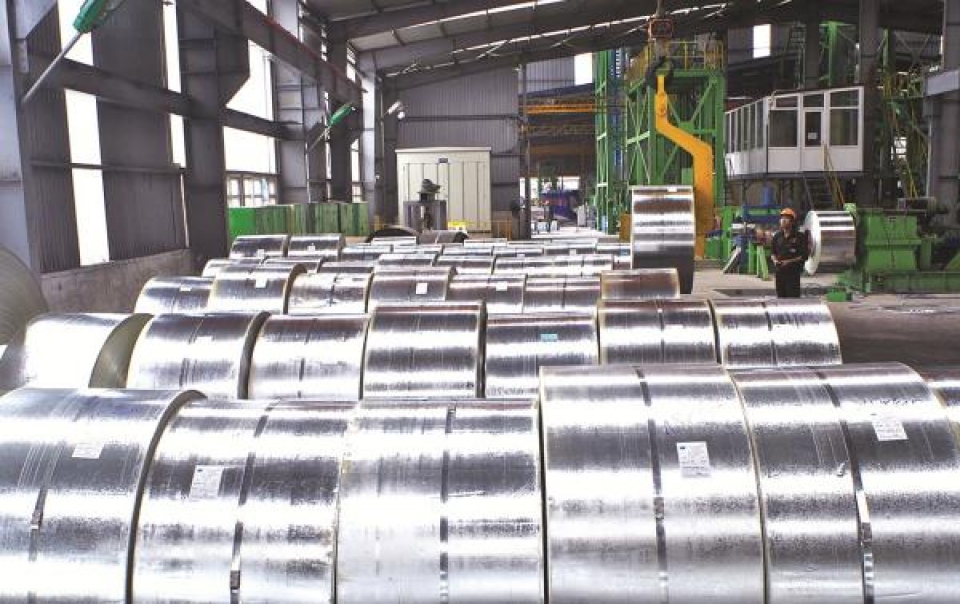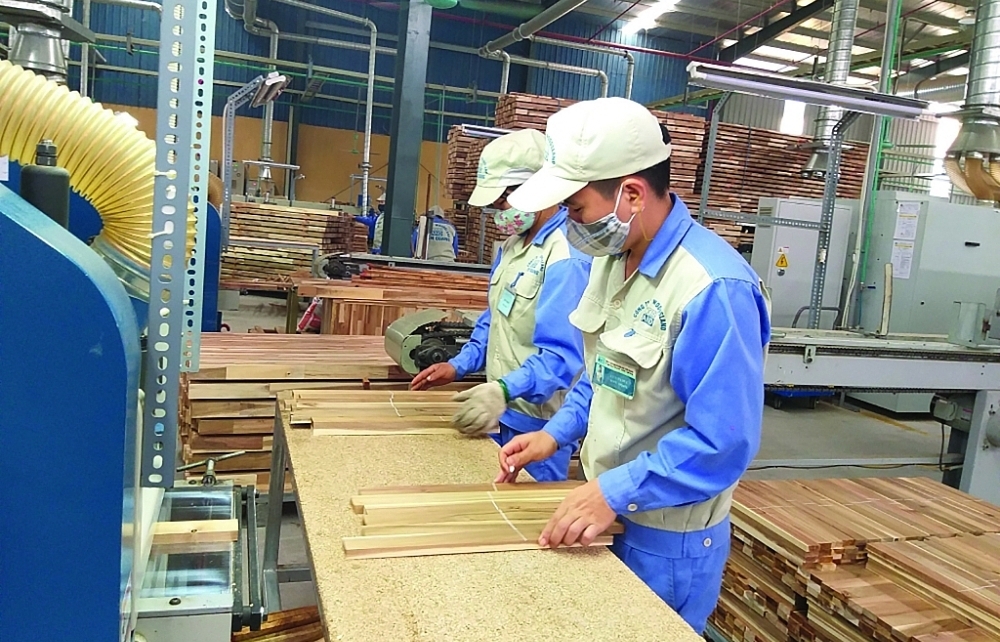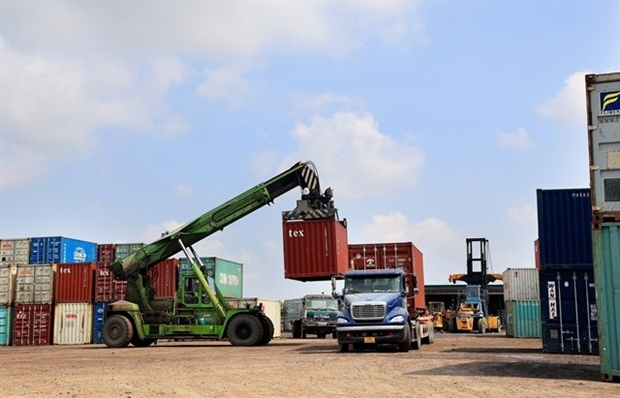Steel industry in litigation
 |
| Restructuring the export market, avoiding exporting to only one market is a feasible solution to help businesses restrict trade lawsuits. Photo: Uyen Nhu. |
Top of the goods being sued
Historically, among the export items of Vietnam, iron and steel are the items that have been "involved" in many Vietnam’s trade defense lawsuits. According to the information provided by Ms. Nguyen Thi Thu Trang, director of the WTO and Integration Center (VCCI) at a workshop held in late June, up to that time, Vietnam has been sued in 78 anti-dumping cases. For anti-subsidy cases, the statistics were 12 cases and 17 cases of anti-tax lawsuit anti-dumping. Remarkably, of the 78 anti-dumping cases, 37 cases were related to iron and steel, accounting for almost half of the goods being sued. Nearly three quarters of anti-subsidy cases are also related to iron and steel.
In recent years, trade remedy lawsuits related to steel have been on the rise. From July 16th to August 9th alone, Vietnamese steel has been sued for commercial defenses and imposed temporary safeguard duties from 7 markets (including Thailand, EU, Canada, Malaysia, the US, Asia-Europe, India) with 8 cases. Only in the US market, just a few days apart, Vietnamese steel has been repeatedly investigated for anti-dumping and anti-subsidy duties.
Specifically, on July 27, the US Department of Commerce (DOC) initiated investigations against anti-dumping and anti-subsidy duties for the anti-corrosion steel (CORE) products from Vietnam because there is a suspicion of anti-dumping and anti-subsidy duties on the CORE steel imported from Korea and anti-dumping duties on the CORE steel imported from Taiwan (China). Subsequently, on August 2, DOC again initiated investigations against anti-dumping and anti-subsidy duties for the CRS steel imported from Vietnam because there is a suspicion of anti-dumping and anti-subsidy duties on the CORE steel imported from Korea.
Talking to the reporter from the Customs Newspaper about the lawsuit situation, Mr. Nguyen Van Sua, Vice president of Vietnam Steel Association (VSA) said that: Recently, trade protectionism is rising radically in the world. The Vietnamese steel industry is being sued for trade remedies from many markets. These lawsuits come from relatively large markets, which are the "backbone" of steel exports. The typical markets include the United States, the EU, some countries in the ASEAN region, even the Eurasian Economic Union.
These lawsuits will directly affect the exportability of Vietnamese steel. "In the recent years, steel exports are increasing year by year. In the first half of 2018, the steel exports still get good results. However, from trade remedies cases, from now until the end of the year to the coming years, the steel exports will face many difficulties. To ensure its growth, the steel industry needs to try hard,” Mr. Sua stated.
Improve competitiveness
Explaining the reasons why Vietnamese steel is constantly involved in trade remedies lawsuits, according to Mr. Sua: First, steel is the raw material for all industries and construction. This is a strategic material that many countries pay attention to. Secondly, in recent years, Vietnamese steel industry has grown rapidly. Besides expanding in the domestic market, steel exports also achieved good results. For example, in 2016, Vietnam exported 3.6 million tons of steel and in 2017 exported 4.7 million tons of steel. This year, with export momentum reaching from the first half of the year, if not prevented by trade remedies lawsuits, the steel exports could definitely reach the figure of over 5 million tons. “Because of the rapid growth rate of steel exports, Vietnamese steel attracts the attention of other countries, and they apply trade remedies measures to protect their domestic production,” Mr. Sua emphasized.
Regarding the lawsuit against anti-dumping and anti-subsidy duties, according to Mr. Sua, the US has recently investigated the occurrence of anti-dumping and anti-subsidy duties on Vietnamese steel sheets using materials from Korea and Taiwan. This also makes it difficult for Vietnam. However, this difficulty can be solved. Since June 2017, Vietnam has been producing raw materials (hot rolled coil steel) to produce sheet steel and corrugated iron. Therefore, in order to avoid the imposition of US taxes, enterprises may use the hot rolled coils of Vietnam. Other markets are similar.
The Ministry of Industry and Trade said that the steel industry continues to have to compete more and more fiercely because imported steel enters strongly into the Vietnam market. In addition, facing many investigations from the importing countries made steel exports difficult. In the coming time, domestic steel companies need to improve their competitiveness, leading to self-reliance of raw materials production inputs in the country. The domestic steel industry must try to close from input to production to eliminate the steel from other countries, minimizing the fact that Vietnam is evading taxes.
Some experts point out that: Steel enterprises need to regularly improve their understanding of international trade; Restructure the export market, avoid exporting to one market only, which leads to export turnover suddenly increasing, creating a reason for the import market to want to sue us.
Regarding this issue, Mr. Sua emphasized: "Vietnam is in the process of industrialization and modernization, the demand for steel is increasing. This is a great opportunity for the steel industry to develop. When being sued from the foreign countries, in order to develop, we have to protect the domestic steel market, prevent the import of products that can be manufactured by ourselves. In the coming time, the Vietnam Steel Association suggested the Ministry of Industry and Trade to promote the use of trade defense tools to protect the domestic steel production.”
From July 16th to August 9th, Vietnamese Steel has been sued for commercial defenses and imposed the temporary self-defense tariffs from 7 markets with 8 cases:
On July 16, the Department of Foreign Trade (DFT)- the Ministry of Commerce of Thailand initiated the second extension of the safeguard measure for hot rolled coil and non-coil products, with or without pattern, 0.9-50.0 mm thickness and 100-3.048 mm width (including 28 HS codes). In this case, if Vietnam exports more than 3% of Thailand's total imports, DFT may not exclude Viet Nam's exports goods from the safeguard measure (if applicable).
On July 18, the European Commission (EC) announced to the World Trade Organization (WTO) that the European Union (EU) will apply the temporary safeguard measures in the investigation, use the safeguard measures with some imported steel products. 3 types of Vietnam's steel products are subjects to be applied, including: Cold Rolled Coils of Alloy and Non-alloy steel, metalized plate steel, and sheet and bar cold rolled stainless steel.
On July 20, the Canada Border Services Agency (CBSA) initiated anti-dumping investigations for some Carbon-Quality Steel Pipe (CWP) originated or imported from Pakistan, the Philippines, Turkey and Vietnam.
On July 24, the Malaysian ministry of international trade and industry (MITI) initiated anti-dumping investigations for some products of galvanized steel coils/sheets or galvanized iron coils/sheets originated or imported from China and Vietnam.
On July 27, the US Department of Commerce has initiated anti-dumping and anti-subsidy duties investigations on corrosion-resistant steel (CORE) products imported from Vietnam, because there is a suspicion of anti-dumping and anti-subsidy on the CORE steel imported from Korea and anti-dumping duties on the CORE steel imported from Taiwan.
On August 2, DOC published the notification initiating anti-dumping and anti-subsidy duties investigations on cold-rolled steel (CRS) imported from Vietnam because there is a suspicion of anti-dumping and anti-subsidy duties on the CRS steel imported from Korea
On August 7th, the Asian-European Union (EEC) Economic Commission issued a notice initiating investigations into the application of global safeguard measures to non-alloy steel products.
Most recently, on August 9, the Directorate General of Trade Remedies (DGTR), under the Ministry of Commerce and Industry of India, initiated the anti-subsidy investigation of stainless steel pipe products originated or imported from China and Vietnam.
Related News

Local steel industry sees recovery momentum
09:42 | 17/08/2024 Import-Export

Exporting wood and wood products recovers positively
10:18 | 09/03/2024 Import-Export

Giving wings to Vietnamese brands in major markets
13:40 | 20/10/2023 Import-Export

Enterprises should explore niche markets amid export decline: ministry
17:30 | 02/08/2023 Import-Export
Latest News

EU partners no longer 'lenient', Vietnam must adapt through ESG policies
09:02 | 05/11/2024 Import-Export

Changes in Canada's trade defense laws
09:00 | 05/11/2024 Import-Export

Import and export are expected to reach 800 billion USD
13:32 | 04/11/2024 Import-Export

Fresh coconuts quenching new overseas markets
13:29 | 04/11/2024 Import-Export
More News

Rice exports likely to set new record in 2024
13:25 | 04/11/2024 Import-Export

Vietnamese goods conquer halal market through trust and quality
09:57 | 04/11/2024 Import-Export

Exporters urged to have strategies to take advantage of UKVFTA for expansion
17:33 | 03/11/2024 Import-Export

Fresh coconuts quenching new overseas markets
17:29 | 03/11/2024 Import-Export

Vietnam and UAE trade sees billion-dollar growth
07:15 | 03/11/2024 Import-Export

Sharing responsibility for ensuring security and safety of the supply chain
07:13 | 03/11/2024 Import-Export

Many factors affecting tuna exports in the last months of the year
19:38 | 02/11/2024 Import-Export

Vietnam still dominates Philippine rice import
19:36 | 02/11/2024 Import-Export
Vietnam cements ties with partners to engage in global semiconductor, AI industries
19:35 | 02/11/2024 Import-Export
Your care

EU partners no longer 'lenient', Vietnam must adapt through ESG policies
09:02 | 05/11/2024 Import-Export

Changes in Canada's trade defense laws
09:00 | 05/11/2024 Import-Export

Import and export are expected to reach 800 billion USD
13:32 | 04/11/2024 Import-Export

Fresh coconuts quenching new overseas markets
13:29 | 04/11/2024 Import-Export

Rice exports likely to set new record in 2024
13:25 | 04/11/2024 Import-Export





